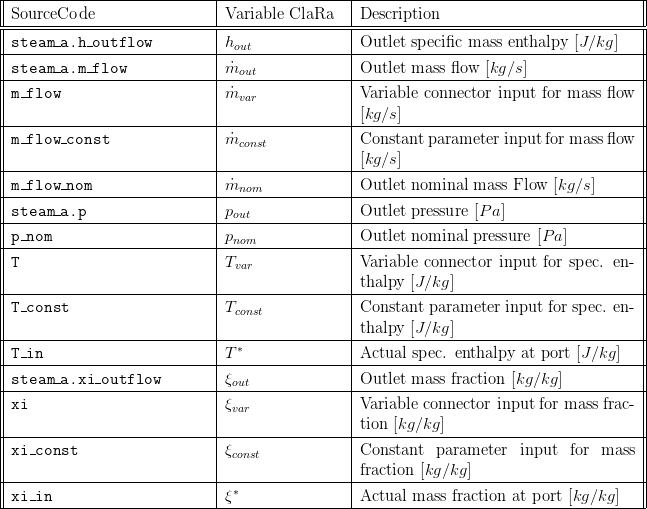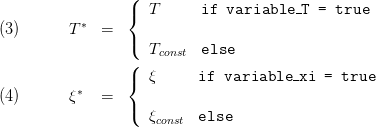BoundaryVLE hxim flow
Created Thursday 13 June 2013
This model provides a the mass flow boundary emitting fluid at a specified temperature and composition. Both, positive and negative flows are supported.
1. Purpose of Model
This model can be used to set up constant or variable boundary conditions for the fluid medium in the water steam cycle. It can either serve as an idealised flow source, where a specified mass flow is emitted from the source with reference to the outside pressure. Alternatively, the source can emit a mass flow depending on the pressure difference between the inside of the source and the outside component connected to it.
2. Level of Detail, Physical Effects Considered and Physical Insight
2.1 Level of Detail
Referring to Brunnemann et al. [1], this model refers to the level of detail L1 because the system is modelled without the use of balance equations.
2.2 Physical Effects Considered
- idealised mass flow at fixed rate, enthalpy and composition
- real mass flow at fixed enthalpy but rate linearly varying with pressure difference between inside and outside of component
2.3 Level of Insight
No different levels of detail are available.
3. Limits of Validity
- Real sources with complex (not only linear) pressure dependence of mass flow cannot be covered by this model.
4. Interfaces
Basics:Interfaces:FluidPortIn steam_a
4.1 Physical Connectors
- Inlet connector combined for:
- Mass flow rate in the connection port [kg/s].
- Thermodynamic pressure in the connection port [Pa].
- Specific thermodynamic enthalpy close to the connection port [J/kg].
- Medium properties at the port.
4.2 Summaries
4.3 Inputs
- Real Input value for:
- Mass flow rate from the source [kg/s].
- Thermodynamic pressure inside source [Pa].
- Temperature close to the connection port [J/kg].
- Medium properties at the port.
4.2 Medium Models.
- Fluid Medium Model at the inlet port
5. Nomenclature

6. Governing Equations
This boundary defines all relevant values for the stream connector used in ClaRa's VLE (vapour-liquid equilibrium) media based models. The pressure is a variable in this set of equations while the mass flow is predefined. The definition of the mass flow can be either variable (via a conditional input connector) or constant (via a parameter) and it can be ideal (thus strictly following the user input) or non-ideal (thus correcting the user input according to a linear pressure dependency).

Note that according to ClaRa's sign paradigm which is in accordance to the Modelica.Fluid's paradigm the boundary will act as source if the given values for  or
or  are positive. Respective negative values make the boundary to a sink.
are positive. Respective negative values make the boundary to a sink.
According to the definition of stream connectors its stream variables must be defined for the source case  or
or  :
:


If the boundary acts permanently or temporarily as a sink the equations (3) and (4) will not be evaluated.
7. Remarks for Usage
- If operated as an ideal boundary source, the model emits the set up mass flow, no matter what the physical conditions in the adjacent components are. There might be situations (e.g. a closing valve) where this leads to termination of the simulation due to the occurrence of non-physical pressures.
- If the model is operated as a real source by setting
 , such non-physical behaviour can be avoided. However, for the real source operation the mass flow emitted from the source only agrees with the set up values if
, such non-physical behaviour can be avoided. However, for the real source operation the mass flow emitted from the source only agrees with the set up values if  .
. - In a number of VLE media the two-phase state can not be defined uniquely by pressure and temperature and the port state will jump from boiling state to dew state.
- the boundary's spec. enthalpy depends on pressure and temperature. This means that the spec. enthalpy may vary under isothermal conditions due to pressure variations and vice versa.
8. Validation
9. References
[1] Johannes Brunnemann and Friedrich Gottelt, Kai Wellner, Ala Renz, André Thüring, Volker Röder, Christoph Hasenbein, Christian Schulze, Gerhard Schmitz, Jörg Eiden: "Status of ClaRaCCS: Modelling and Simulationof Coal-Fired Power Plants with CO2 capture", 9th Modelica Conference, Munich, Germany, 2012
10. Authorship and Copyright Statement for original (initial) Contribution
Author:
DYNCAP/DYNSTART development team, Copyright 2011 - 2022.
Remarks:
This component was developed during DYNCAP/DYNSTART projects.
Acknowledgements:
ClaRa originated from the collaborative research projects DYNCAP and DYNSTART. Both research projects were supported by the German Federal Ministry for Economic Affairs and Energy (FKZ 03ET2009 and FKZ 03ET7060).
CLA:
The author(s) have agreed to ClaRa CLA, version 1.0. See https://claralib.com/pdf/CLA.pdf
By agreeing to ClaRa CLA, version 1.0 the author has granted the ClaRa development team a permanent right to use and modify his initial contribution as well as to publish it or its modified versions under the 3-clause BSD License.
11. Version History
- 2013-06-18 - v 0.1 - initial implementation - Johannes Brunnemann XRG Simulation
